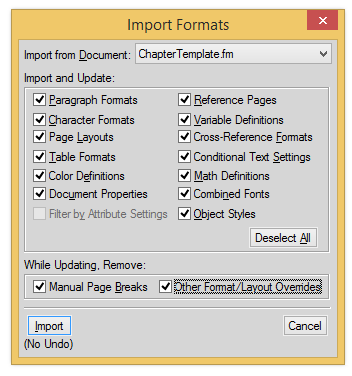
What exactly is a FrameMaker Template?
Let’s start with a few simple assumptions about FrameMaker.
FrameMaker is great for:
- maintaining long documents
- maintaining documents with a long lifecycle
FrameMaker is not great for
- memos
- marketing collateral
- anything where formatting and design is more important than the content
And, importantly, FrameMaker is most efficient when you maintain your formatting in a separate template document.
That last bit about using the importance of a FrameMaker template is interesting, because there’s no official template file or file format inside of FrameMaker!
Framemaker Template, defined
A template stores formatting information so that it can be applied to one or more documents to ensure consistency.
Still, that’s a bit sterile, so here’s a piece of information that you can use right away to start getting your docs under control…
To apply the formats contained in a FrameMaker template to your document(s), use the File > Import > Formats command.
If you can easily import a format definition from one doc to another, it can be part of your template.
The inverse is also true: If you can’t easily import formatting information from one doc to another, it’s not part of your template and must be maintained separately.

The options are mostly self-explanatory, but the Page Layouts option should be labeled Master Pages, and the Document Properties option is a mish-mash of options, including view options, document and page numbering, and pretty much anything else without a home.
Click here to receive a video I created on templates, and a template-based workflow.

Join over 4,300 of your peers and get my latest content sent to you for free, along with some of my all-time favorites.